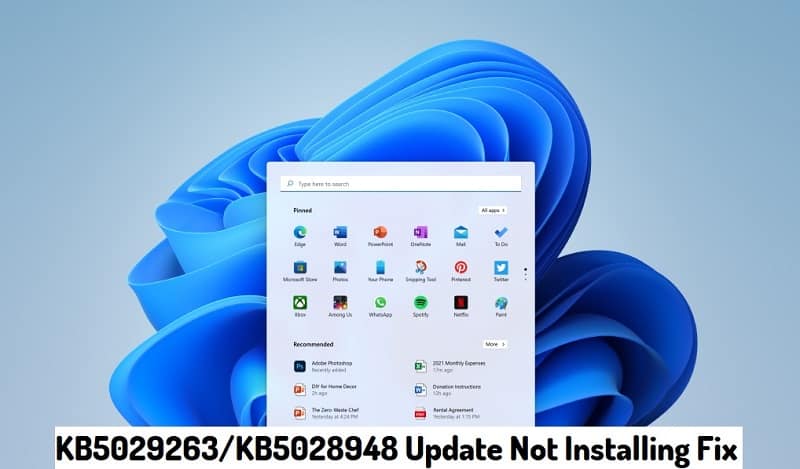Windows updates are crucial for keeping your operating system secure and up-to-date with the latest features. However, encountering issues while installing or downloading updates, such as KB5029263 or KB5028948 for Windows 11, can be frustrating. Microsoft recently pushed the latest Windows 11 KB5029263 and KB5028948 updates designed to bring essential improvements, bug fixes, and security enhancements to your operating system.
However, it appears that a lot of users have encountered an error where these updates fail to install or not downloading for many. In this article, we’ll delve into what the Windows 11 KB5029263/KB5028948 update not installing error is, its possible fixes, and why it occurs.
What is Windows 11 KB5029263/KB5028948 Update Not Installing Error on PC?
When you attempt to install the Windows 11 updates KB5029263 or KB5028948, you might encounter an error that prevents the installation process from completing successfully. This error message is typically accompanied by a specific error code, such as 0x80070002. This code signifies that certain files required for the update could not be located or accessed, hindering the installation process.
Possible Reasons for Win 11 KB5029263/KB5028948 Update Not Installing Error
Several factors can contribute to the Windows 11 KB5029263/KB5028948 update not installing error:
- Corrupted Update Files: The update files themselves might be corrupted during the download process, preventing a successful installation.
- Software Conflicts: Third-party applications, especially antivirus software, can interfere with the update process and prevent the installation from proceeding.
- Insufficient Disk Space: If your system’s storage is nearly full, there might not be enough space to accommodate the update files, causing the installation to fail.
- Internet Connectivity Issues: Poor or unstable internet connectivity can interrupt the download of update files, leading to installation failures.
- Windows Update Service Glitches: Problems with the Windows Update service or related components can prevent updates from being installed.
- Date and Time Settings: Incorrect date and time settings can lead to errors during the update process.
- System File Corruption: Corruption of essential system files can interfere with the update process, resulting in installation errors.
- Background Applications: Background applications running on your system might conflict with the update process and hinder successful installation.
Implications of the Error
Failing to install important updates like KB5029263 and KB5028948 can have various implications:
- Security Vulnerabilities: Updates often contain critical security patches that protect your system from vulnerabilities and potential cyber threats. Failing to install these updates can leave your computer at risk.
- Bugs and Glitches: Updates also address bugs, glitches, and performance issues. Not installing updates can lead to ongoing problems and decreased system performance.
- Feature Enhancements: Updates can bring new features, improved functionality, and enhanced user experience. Not installing updates means missing out on these improvements.
How to Fix Windows 11 KB5029263/KB5028948 Update Not Installing/Downloading On PC
Method 1: Running Windows Update Troubleshooter
The Windows Update Troubleshooter is a built-in tool designed to diagnose and automatically resolve issues related to Windows updates. To run the troubleshooter:
- Press Windows + I to open the Settings menu.
- Click on Update & Security.
- Select Troubleshoot from the left-hand side menu.
- Click on Additional troubleshooters.
- Locate Windows Update and click Run the troubleshooter.
- Follow the on-screen instructions to complete the troubleshooting process.
If the troubleshooter detects and fixes any issues, attempt to install the updates again.
Method 2: Clearing Windows Update Cache
The Windows Update cache stores temporary files related to Windows updates. Clearing this cache can sometimes resolve update-related errors. Here’s how:
- Press Windows + S, type Services, and open the Services app.
- Scroll down and locate Windows Update.
- Right-click on it and select Stop. Minimize the Services app.
- Press Windows + E to open File Explorer.
- Navigate to C:\Windows\SoftwareDistribution.
- Delete all the contents of the SoftwareDistribution folder. You might need administrator permissions.
- Maximize the Services app again, right-click on Windows Update, and select Start.
- Try installing the updates once more.
Method 3: Check System Date and Time Settings
Incorrect date and time settings can interfere with the Windows update process. Make sure your system’s date and time settings are accurate:
- Right-click on the Date and Time in the taskbar.
- Select Adjust date/time.
- Toggle off Set time automatically.
- Manually adjust the date and time if necessary.
- Toggle Set time automatically back on.
Method 4: Disable Third-Party Antivirus
Sometimes, third-party antivirus software can hinder the Windows update process. Temporarily disable your antivirus and try updating Windows again:
- Locate your antivirus software’s icon in the system tray.
- Right-click on the icon and look for an option like Disable or Pause protection.
- Choose a timeframe for how long you want the antivirus protection to be disabled.
- After the chosen time elapses, enable the antivirus protection again.
Method 5: Using Windows 11 Installation Assistant
- Download the Windows 11 Installation Assistant from the official Microsoft website.
- Run the Installation Assistant and follow the on-screen instructions to fix update installation errors.
Method 6: Performing a Clean Boot
A clean boot starts Windows with a minimal set of drivers and startup programs, which can help eliminate software conflicts during the update process:
- Press Windows + R, type msconfig, and press Enter.
- In the System Configuration window, go to the Services tab.
- Check Hide all Microsoft services and click Disable all.
- Go to the Startup tab and click Open Task Manager.
- Disable all startup items from the Task Manager.
- Close the Task Manager and click OK in the System Configuration window.
- Restart your computer and attempt to install the updates.
Method 7: Manually Downloading and Installing Updates
If the automatic update process isn’t working, you can manually download and install the updates from the Microsoft Update Catalog:
- Identify the specific update KB number from Microsoft’s official website.
- Search for the update on the Microsoft Update Catalog.
- Download the appropriate version for your system.
- Double-click the downloaded file to install the update.
Method 8: Check Disk for Errors
Disk errors can sometimes prevent updates from installing correctly. Here’s how to check and fix disk errors:
- Press Windows + S, type Command Prompt, right-click it, and select Run as administrator.
- In the Command Prompt, type chkdsk /f and press Enter.
- You might need to restart your computer. Confirm by typing Y and pressing Enter.
- After the disk check and repairs are complete, try installing the updates again.
Method 9: Reset Windows Update Components
Resetting Windows Update components can often resolve update-related issues caused by corrupted files or settings:
Method 1
This method will automatically stop and restart all the Windows update services on your Windows 11 PC.
- Open Notepad on your PC.
- Now, copy and paste all the commands given below to the Notepad and save it on your desktop with the file name Wufix.bat.
- SC config trustedinstaller start=auto
- net stop bits
- net stop wuauserv
- net stop msiserver
- net stop cryptsvc
- net stop appidsvc
- Ren %Systemroot%\SoftwareDistribution SoftwareDistribution.old
- Ren %Systemroot%\System32\catroot2 catroot2.old
- regsvr32.exe /s atl.dll
- regsvr32.exe /s urlmon.dll
- regsvr32.exe /s mshtml.dll
- netsh winsock reset
- netsh winsock reset proxy
- rundll32.exe pnpclean.dll,RunDLL_PnpClean /DRIVERS /MAXCLEAN
- dism /Online /Cleanup-image /ScanHealth
- dism /Online /Cleanup-image /CheckHealth
- dism /Online /Cleanup-image /RestoreHealth
- dism /Online /Cleanup-image /StartComponentCleanup
- Sfc /ScanNow
- net start bits
- net start wuauserv
- net start msiserver
- net start cryptsvc
- net start appidsvc
- Right-click on the Wufix file and click Run as administrator.
- Restart your PC.
- After the PC restarts, try installing or updating your Windows 11 again, and the error shouldn’t be there.
Method 2
- Open the Command Prompt as an administrator.
- Type the following commands one by one, pressing Enter after each:
- net stop wuauserv
- net stop cryptSvc
- net stop bits
- net stop msiserver
- Next, type ren C:\Windows\SoftwareDistribution SoftwareDistribution.old and press Enter.
- Then, type ren C:\Windows\System32\catroot2 catroot2.old and press Enter.
- Finally, restart the services by typing the following commands:
- net start wuauserv
- net start cryptSvc
- net start bits
- net start msiserver
- Close the Command Prompt and attempt to install the update again.
Method 10: System Restore
If none of the above methods work and you recently made changes to your system, you can try a system restore:
- Press Windows + S, type Create a restore point, and open the corresponding setting.
- Click System Restore and follow the prompts to restore your system to a point before the problematic update.
Method 11: Update Windows 11 Using Media Creation Tool
- Visit the official Microsoft website and download the “Windows 11 Media Creation Tool.” using the second option which is “Create Windows 11 Installation Media.”
- Download the tool and run it on a working computer.
- Accept the terms and conditions, and select the option to “Create installation media (USB flash drive, DVD, or ISO file) for another PC.”
- Choose the language, edition, and architecture (32-bit or 64-bit) that matches your system.
- Select either a USB flash drive or ISO file as the installation media.
- If using a USB flash drive, connect it to the computer, and select the appropriate drive.
- Wait for the Media Creation Tool to download the necessary files and create the bootable media.
- Once the process is complete, restart the computer and boot from the USB drive or DVD.
- Follow the on-screen instructions to install a fresh copy of Windows 11.
- During the installation, you may be prompted to enter your product key. Ensure you have it handy.
- Follow the remaining steps to complete the installation.
- After the installation is finished, reinstall your necessary applications and restore your backed-up files.
Method 12: Use Microsoft Update Catalog
If all else fails, you can manually download the KB5029263/KB5028948 update from the Microsoft Update Catalog and install it on your system. Follow these steps:
- Visit the Microsoft Update Catalog website.
- In the search bar, type “KB5029263/KB5028948” and press Enter.
- Locate the appropriate update for your system architecture and click on the “Download” button next to it.
- Once the update is downloaded, double-click on the file to begin the installation process.
- Follow the on-screen instructions to complete the installation.
Contact Microsoft Support
If all else fails and you’re still struggling with Error Code 0x80070002, it might be time to reach out to Microsoft Support. They can provide tailored assistance to help you resolve the issue.
Conclusion
Encountering the Windows 11 KB5029263/KB5028948 update not installing error can be frustrating, but understanding the possible causes can help you troubleshoot and resolve the issue. In the following sections, we will explore various methods to fix this error and ensure that you can successfully install these important Windows 11 updates.








